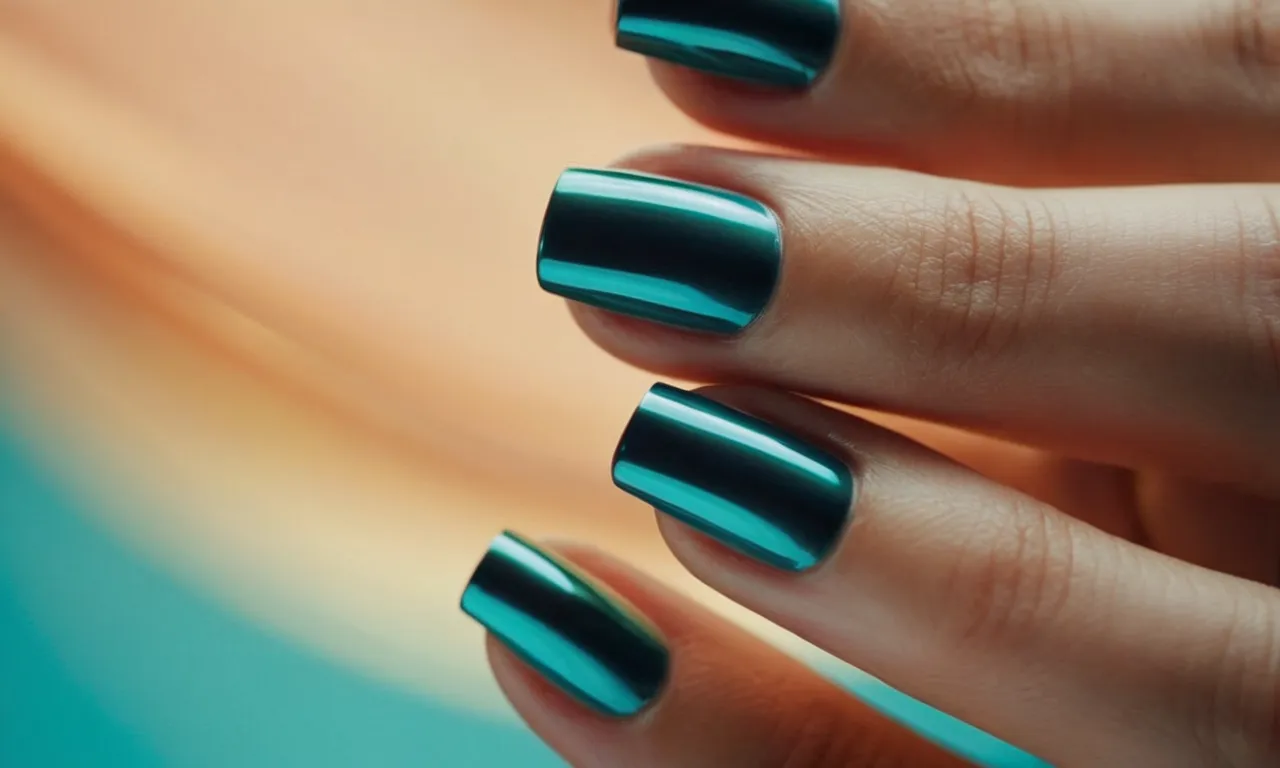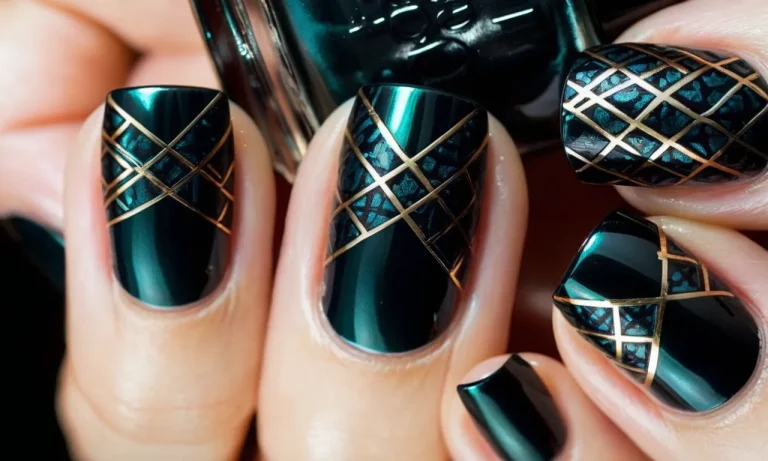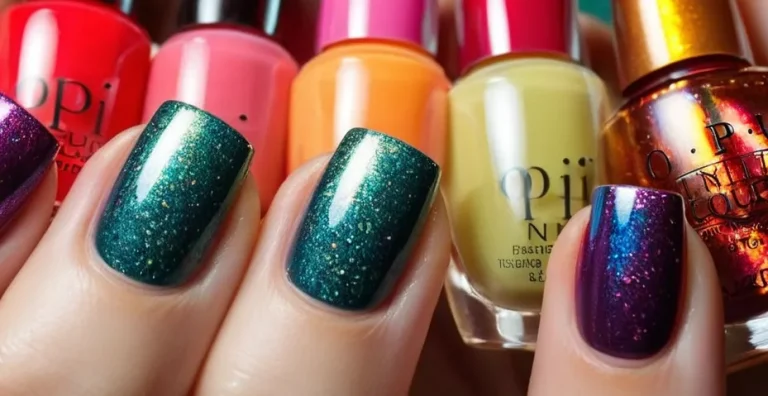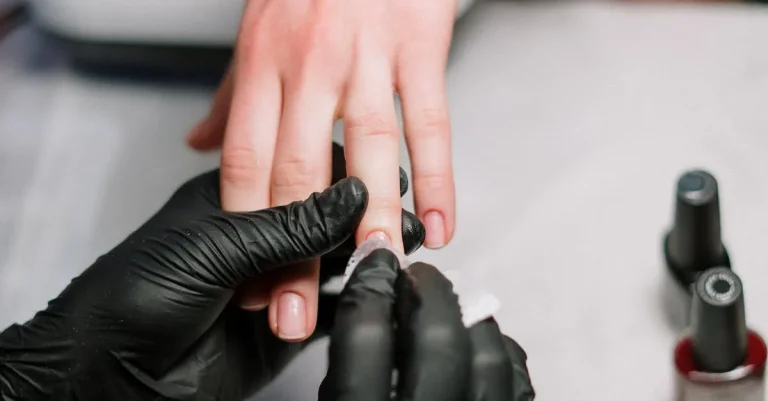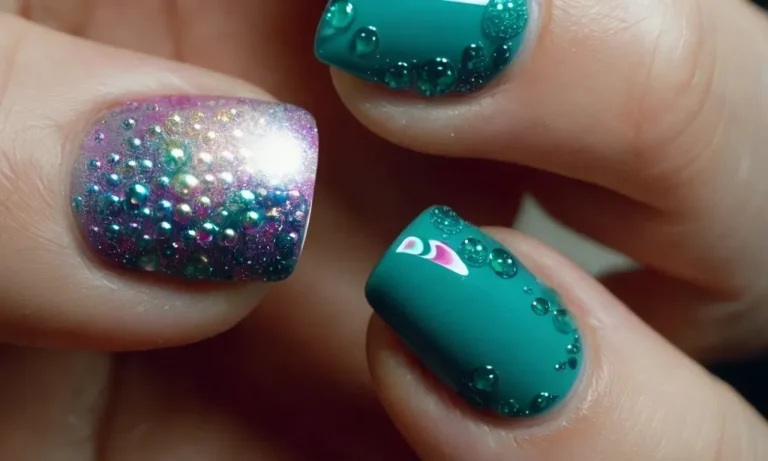How To Tell If Nail Polish Is Dry Without Touching It
Applying nail polish can be tedious when you have to sit still waiting for it to dry. But there are ways to test if your manicure is dry without ruining your nails or having to wait a full hour.
If you’re short on time, here’s the quick answer: look closely at the surface of the polish for sign that is has hardened and is no longer wet and tacky. You can also hold your hand close to your face and gently blow air over your nails – if the polish doesn’t ripple, it’s likely dry.
In this comprehensive guide, we will cover several techniques you can use to accurately determine if your nail polish is dry, including visual tests, the breath test, touching surrounding skin, and more.
Look Closely at the Polish Surface
When nail polish starts to dry, you’ll notice some clear signs by closely examining the surface, texture, and thickness of the polish.
Check for shine and texture changes
As polish dries, the shine will start to dull and the smooth, glossy wet texture will transition to a hardened feel. Carefully observe if the high gloss has reduced slightly and the polish lacks the slick, smooth appearance of the initial application.
These subtle changes indicate the nail lacquer is beginning to dry and set.
You can also look for very slight imprints or marks if you gently run an object (like the blunt end of a toothpick) over the polish. Wet polish will remain flawless, while drying polish may show faint lines.
As long as the object doesn’t stick to or pull up the polish, seeing superficial scratches means it’s drying and becoming more solid.
See if it’s thickened and hardened
Test how thick the polish has become by gently touching an applicator brush to the surface to see if it slides through the lacquer or drags across more stiffly. When wet, the brush will swoosh smoothly, but it will move slower through thickened polish as it dries.
You can also examine the polish on the brush itself. If the brush has polish on it but it appears thicker and clumped rather than smooth and liquidy, that shows the original application is setting up.
Lastly, see if the polish has hardened by lightly dusting over the nails with a soft makeup brush to remove any droplets or debris on the surface. Wet polish will stick and cling to the brush, while hardened polish will remain intact.
Absence of any disturbances on the nail indicates the polish has likely dried and cured.
Do the Breath Test
One of the easiest ways to check if your nail polish is dry is to do the breath test. This involves gently blowing air onto your freshly painted nails from a distance of about 2 inches. If the nail polish doesn’t smudge or get disturbed by your breath, then it means the polish has dried and cured enough for light activity.
This is an effective trick as the moisture in your breath acts as a mini humidity test. If the polish is still wet or tacky, the moisture will affect it and cause it to streak or smudge. However, if it’s dry to the touch, your breath shouldn’t have any effect.
Steps to Follow
Doing the breath test properly ensures accurate results. Follow these steps:
- Wait at least 10 minutes after applying the last coat of nail polish before testing.
- Hold your hand steady and stretch your fingers out straight.
- Purse your lips and gently blow air towards your nails from a distance of about 2 inches.
- Aim the air at different parts of each nail to check the whole area.
- Check closely for any smudging, streaking or other disturbance on the nail polish.
- If there is no effect, it means the polish has sufficiently dried and cured. It’s safe for light activity without messing up your manicure.
Factors that Affect Results
The results of the breath test can vary depending on several factors:
- Number of coats applied – More coats means longer drying time. Allow adequate drying time before testing.
- Type of nail polish – Quick-dry polishes dry faster than regular lacquers.
- Humidity and temperature – Nail polish dries slower in a humid environment and cold temperatures.
- Ventilation – Good airflow facilitates evaporation of solvents in nail lacquer and helps in faster drying.
Keeping these factors in mind will help you interpret the results accurately. Remember that the breath test just checks for surface dryness. Even if your nails pass this test, its best to avoid water exposure or friction for a few hours to allow thorough drying between manicure layers.
Other Methods to Test Dryness
Along with the simple breath test, some other ways to test nail polish dryness without direct contact include:
- The hand wave test – Gently wave your hands in the air and see if the nail polish feels sticky or tacky.
- Typing test – Lightly type on your keyboard or mobile screen and check if the polish gets imprinted.
- Dust test – Sprinkle some talcum powder or blush over the painted nails from few inches away. Smudging indicates it’s still wet.
Each test checks dryness based on a different external factor. Using a combination of 2-3 tests yields the most reliable results to determine if your manicure is ready for stress-free activity.
With the do-it-yourself breath technique and other indirect methods, you can easily find out if your nail color has dried without needing to touch up and ruin your polish job.
Touch the Skin Surrounding Your Nails
One easy way to check if your nail polish is fully dry is by gently touching the skin surrounding your nails. Be very careful not to actually touch the painted nails when doing this test, as you may end up with distorted polish or fingerprints if the polish is still wet.
When you lightly touch the skin near the nails, if the polish feels smooth, dry and not sticky at all, there’s a good chance it has dried properly. However, if you feel any slight stickiness or tackiness on the adjacent skin, that’s an indication that the nail polish likely needs more time to cure and harden fully.
Why This Test Works
When nail polish is still wet or not fully set, some of the lingering vapors, solvents and polymers can transfer onto anything that touches it. So if you touch the skin next to your painted nails and feel any residue, stickiness or tackiness, it means the polish is still off-gassing and has not completely hardened.
This easy touch test lets you check polish dryness without actually disturbing the liquid lacquer itself. Very gently touching the nearby skin can indicate if there is any wetness without marring the glossy polish finish you just painted on.
Tips for Best Results
To accurately test for nail polish dryness using the surrounding skin:
- Wait at least 10 minutes after applying the last coat before trying to test dryness.
- Be sure not to blow or wave your hands trying to hurry the drying process.
- Gently pinch the skin near the cuticle and base of the nail bed.
- Do not touch any area close to the painted nail tips when testing.
- See if the skin transfers any color or feels tacky or sticky.
- If you notice any texture changes on the skin, wait longer before assessing again.
With this simple technique of feeling the nearby skin for stickiness, you can confirm if your polish application has hardened completely or needs a bit longer drying time.
See If the Polish Smears When Touched Lightly
One of the easiest ways to test if your nail polish is dry is to gently touch it and see if it smears. This simple test requires no special tools and can be done in seconds.
How to Do the Light Touch Test
Follow these simple steps to perform the light touch nail polish test:
- Wait at least 10 minutes after applying the last coat of polish. This gives it some time to set.
- Use a finger on your other hand to lightly touch the polish. Don’t press hard or drag your finger across.
- See if any color comes off onto your finger. If it does, the polish isn’t fully dried yet.
- Repeat every few minutes, testing different areas of the nails, until nothing transfers.
The key with this method is to use a very gentle touch. You don’t want to smear the polish if it’s still wet. Just a faint tap is all you need to see if it’s ready or not.
What a Smear Means
If you see traces of color on your finger, it means some parts of the polish are still wet. This is common with dark colors or thick glitters, which tend to dry slower than lighter shades.
Don’t panic if it smears! Just let your nails continue air drying and test again later. The polish will eventually harden completely. For quicker drying, you can try using a fast-dry top coat or waving your hands to circulate the air.
No Smears? Your Manicure is Set!
If your test finger comes away clean after gently touching the surface of the polish, congratulations – your mani has officially dried! Now you can comfortably move on with your day without worrying about smudges or dents.
This light touch test lets you confirm dryness without ruining all your hard work. No more impatiently poking and prodding! Just a simple finger tap will give you the answer. 👍 It’s a quick sanity check before you text, type, eat, or handle other tasks that might mess up freshly painted nails.
Give it a try for easy, smear-free results!
Consider Environmental Temperature and Humidity
The environment’s temperature and humidity levels can significantly impact how quickly nail polish dries. Here’s what you need to know:
Warmer Temperatures Speed Up Drying
Nail polish contains solvents that evaporate as the polish dries. Heat speeds up evaporation, so polish will dry faster in warmer environments. For best results, apply polish in a room that’s 70-80°F if possible.
Cooler Temps Slow Down Drying
On the flip side, colder temps cause the solvents in nail polish to evaporate more slowly. So if you apply polish in a chilly room, expect it to take longer to fully cure. If it’s cold, run a space heater to warm things up beforehand.
Lower Humidity Helps Polish Dry Quicker
Since humidity refers to the amount of moisture in the air, high humidity levels get in the way of lacquer drying efficiently. Less water vapor in the air allows for faster solvent evaporation.
According to research, the optimal humidity for quick-drying nails is around 40-60% relative humidity. Use a humidifier to lower extremely high humidity if needed.
Avoid Extreme Heat or AC Blasts
While heat does accelerate drying, you don’t want your nails to get too hot. Very warm temperatures can actually cause bubbling or other polish application issues.
Similarly, avoid positioning freshly painted nails right in front of a blasting AC or fan. The cold air can shock the lacquer and prevent proper curing.
Conclusion
By visually inspecting for signs of drying, doing the breath test, and gently touching the skin around your nails, you can accurately determine if your nail polish is dry enough between coats or ready for top coat without risking mistakes. Pay attention to environmental factors as well.
With this knowledge, you can have salon-perfect nails in record time.

